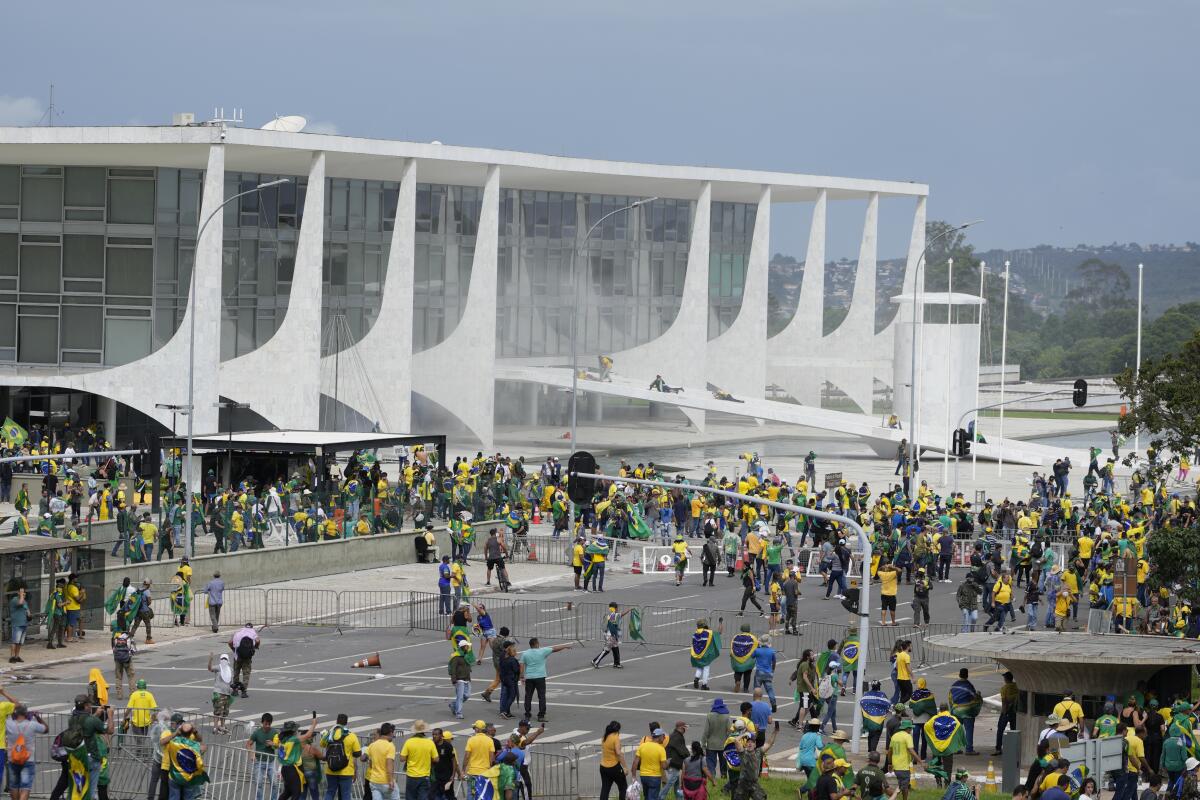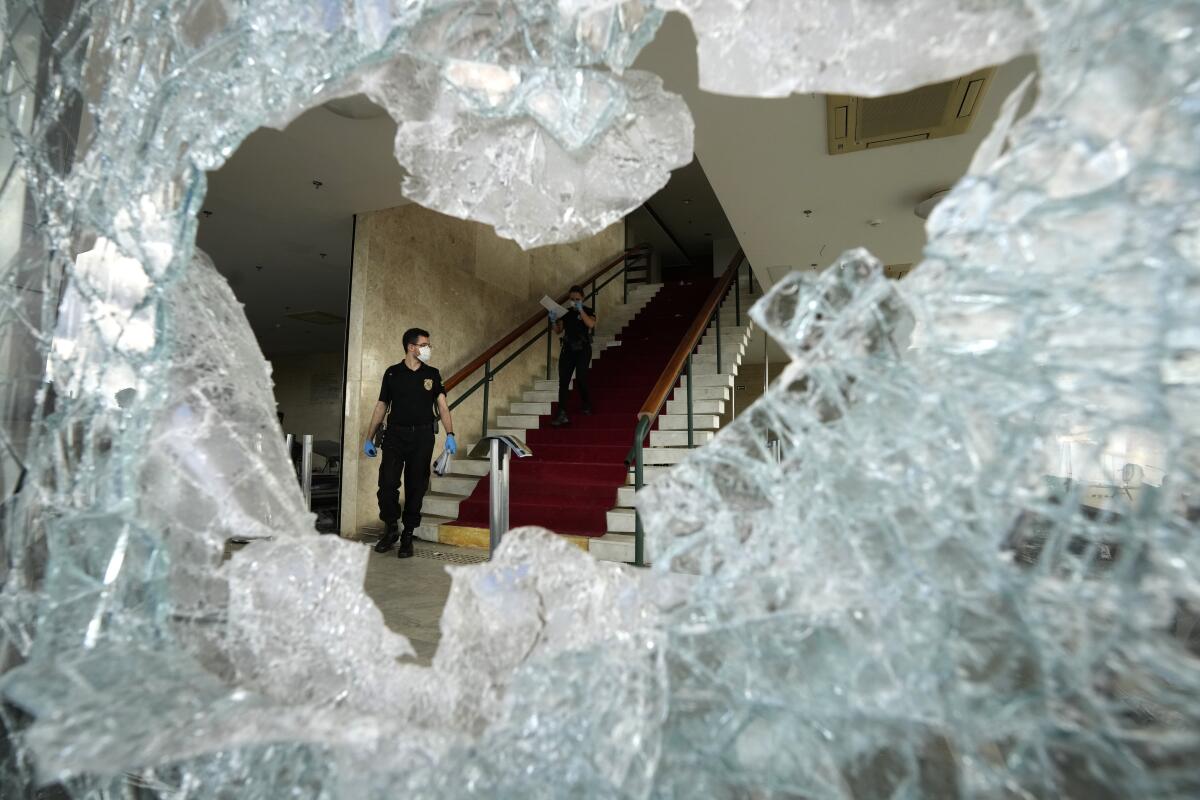Brasilia, Oscar Niemeyer’s Modernist masterpiece, becomes a stage for right-wing insurrection

- Share via
Jackie, the bald eagle who lives at Big Bear, has laid her first egg of 2023 — and she is looking proud. I’m Carolina A. Miranda, art and design columnist at the Los Angeles Times, and I’m here with all your essential arts and raptor reproduction news:
Brasília overrun
It felt like a grotesque re-imagining of Groundhog Day. Forty-eight hours after the anniversary of the Jan. 6 insurrection in the United States, in which right-wingers weaned on conspiracy theories about a presidential election stormed the U.S. Capitol, supporters of the outgoing, right-wing Brazilian president Jair Bolsonaro did much the same. Over the course of Jan. 8, rioters dressed in the colors of the Brazilian flag overran the Modernist buildings that make up the government complex in the capital of Brasília, an acclaimed World Heritage site designed by Brazilian architect Oscar Niemeyer.
Rioters then proceeded to tear the place up.

On Thursday, Brazil’s artistic heritage institute released a 50-page photographic report on the extensive damages. These included shattered windows at all of the city’s architectural icons, crushed furniture, torn paintings and carpets soaked in water and urine. A desk used by former President Juscelino Kubitschek, the leader who oversaw the construction of Brasília, was employed as a barricade. Among the countless smashed items was a rare 17th century clock fabricated by Balthazar Martinot and a stained glass window by Marianne Peretti, the only woman on the artist team that worked on Brasília in the 1950s.
The cost of the damages has yet to be tallied, but UNESCO, which manages the world heritage program, announced that it will join efforts to help Brazil restore its cultural heritage.
Make the most of L.A.
Get our guide to events and happenings in the SoCal arts scene. In your inbox every Monday and Friday morning.
You may occasionally receive promotional content from the Los Angeles Times.
In so many ways, an attack on these architectonic treasures reads like an attack on democratic ideals. The city is utopic in its design and embodies a unique strain of Latin Americanist thought, popular in the middle of the 20th century, when the continent’s elites were looking inward for solutions rather than simply parroting European ideas (a topic I wrote about for Architect magazine upon Niemeyer’s death in 2012).
But, like any construction, the story of how these buildings were created is complex — a story that is also about the ways power is wielded.
The construction of Brasília was a monumental undertaking run by a chosen few. There was Kubitschek, who managed the politics and scared up the funds (at times, fulfilling the role of Latin American strongman); Niemeyer, who designed all of the buildings; and Lucio Costa, who was in charge of the urban plan. As I noted in Architect, despite all of its stated ideals, “Brasília wasn’t designed with the intent of making life good for the little guy. Its large scale, Costa explained, communicated that ‘the city isn’t a province, but a capital’; the cross these axes carved into the savannah was an ‘act of possession.’”

Brazilian writer Giovana Martino, in a dispatch published in ArchDaily this week, elaborates on those ideas: “As a space and object, [Brasília] is a landmark of modernism and Brazilian architecture. However, it was built using exploited migrant, poor and racialized workforce. Politically, it is a city that was built upon the discourse of democracy and transparency. Yet, it is strategically located far, almost isolated, from the country’s largest urban centers.”
In his 1994 book, “Oscar Niemeyer and the Architecture of Brazil,” historian David Underwood described the city as one “born of imperial ambitions and as such could only reinforce the existing colonial structure.”
Niemeyer embodied these contradictions himself. He continued to work on Brasília after the Brazilian military seized power in 1964 — designing the capital’s Ministry of Defense even as the military made his life hell. (Niemeyer was a communist who frequently found himself in the crosshairs of the regime.)
Whatever the nuances of its creation, Brasília is nonetheless the preeminent symbol of the Brazilian state and, ultimately, the will of its people — people who, incidentally, voted Bolsonaro out of office in October. Six decades out, Niemeyer’s structures retain an ebullient optimism. And their symbolism extends well beyond Brazil’s borders; to the world, they mark an era.
On and off the stage
Times theater critic Charles McNulty got a very hard-to-get appointment with shrink-to-the-stars Phil Stutz, who is the subject of a recent documentary by actor and client Jonah Hill titled “Stutz.” And in a piece that is as much a working session as it is an interview, McNulty gets into the work of a psychiatrist who “pooh poohs Freudian protocol.”

John Rubinstein appears as the former president in “Eisenhower: This Piece of Ground,” on view at the Hudson MainStage Theatre. It’s a role, writes McNulty, that the actor assumes “with such concentrated ease that it’s as if a figure known to some only through grainy news footage and the term ‘military industrial complex’ (which he famously issued as a warning) has been allowed a temporary reprieve from death to talk some sense into a nation that has lost its way.”
Design time
I made a visit to Stone Mountain, Georgia, last May to get a gander at what is described as the largest Confederate monument in the world. It’s a literal scar on the landscape: a supersize bas relief of Confederate leaders carved into a massive granite outcropping. In addition, its history is inextricably linked to the rise of the modern Ku Klux Klan. This week, the Atlanta History Center released a compelling new short doc that digs into the monument’s troubled history — and I had a look.
Enjoying this newsletter? Consider subscribing to the Los Angeles Times
Your support helps us deliver the news that matters most. Become a subscriber.
The new Morphosis-designed Orange County Museum of Art has made headlines and kept social media tittering over its very sloppy finishes. (Think: foam core and artist tape.) Now the museum will close down for three weeks to work on the needed fixes. As I note in my story on the debacle, “when it comes to a structure with a $94-million price tag, it’d be nice if it vaguely resembled the glossy images that are being distributed to the press.”

Classical notes
Michael Tilson Thomas is in treatment for an aggressive cancer in his brain, but his illness hasn’t kept him off the podium. Times classical music critic Mark Swed was in the audience at Disney Hall last week to see MTT, as he is known, lead Debussy’s “Prelude to the Afternoon of a Faun” and Messiaen’s “Trois Petites Liturgies de la Présence Divine,” after which he sat down for a wide-ranging interview with the celebrated conductor. “I’m still dying,” he says. “But not as quickly as you would originally suppose.”

At the Highland Park Ebell Club, Pacific Opera Project staged the U.S. premiere of Vivaldi’s “Ercole Su’l Termodonte” (Hercules on the River Thermodon) and it was the sort of homegrown affair that gave a sense of “operatic immediacy” writes Swed. “The production by Josh Shaw, who founded POP a decade ago, has some of his trademark jokiness that turns into gripping theatricality in a surprising instant.”
ESPN’s College Football Playoff National Championship has an epic theme titled “Of Grit and Glory.” And it is written by none other than Oscar-winning composer John Williams, reports Jessica Gelt.
Artistic controversy
A Minnesota adjunct professor did not have her contract renewed after showing historic, centuries-old images of the Islamic prophet Muhammad in an art history class. Times columnist Robin Abcarian reports on how the charges of Islamophobia simply do not wash.
Awards season
As winners came forward to claim their Golden Globes on Tuesday, speeches were cut off by piano music. Except the music wasn’t being produced by the event’s pianist, Chloe Flower — it was taped. Even so, she took the heat for it on social media. She tells Jessica Gelt all about the event.
Find all of The Times’ Golden Globes coverage at this link — including comedian Jerrod Carmichael‘s pointed opening monologue.

Essential happenings
My colleague Steven Vargas is kicking off the year with his latest roundup for L.A. Goes Out, his weekly newsletter. This includes a dance festival at the Odyssey Theatre and painter Jim Shaw‘s latest at Gagosian. Want to be in-the-know on where to go? You can sign up for the newsletter here.
Plus, Matt Cooper has the latest edition of the culture guide up and it’s got everything in one handy map, including opera, dance, experimental film and retro swing.
Moves
The Andy Warhol Foundation has announced the recipients of its fall grant cycle, which includes $4 million in grants to 48 arts organizations. They include the San Francisco Cinematheque, the 18th Street Arts Center in Santa Monica, and MOCA Los Angeles, which is teaming up with LAXART for the upcoming exhibition “Monuments.”
The National Endowment for the Humanities announced $28.1 million in grants to 204 humanities projects, including a Chinatown history project led by USC professor William Deverell and a project by Stanford historian Katy Long that will examine the deportation of Mexican Americans in the 1930s.
The Mohn LAND Grants are a new grant issued by Los Angeles Nomadic Division and funded by philanthropist Jarl Mohn to support emerging L.A. artists. This year’s recipients are Star Feliz, Maria Maea, Felix Quintana and Jackie Amézquita.

Jean Davidson has been named executive director of the National Symphony Orchestra in Washington, D.C. She was previously the president and chief executive of the L.A. Master Chorale.
Passages
William C. Agee, an art historian and curator who led the Pasadena Art Museum in the 1970s (now the Norton Simon) and, later, the Museum of Fine Arts Houston, has died at 86.
Frank Galati, a Tony Award-winning writer and director known for his critically-acclaimed adaptation of “The Grapes of Wrath,” is dead at 79.
In other news
— The birth of Latin jazz.
— A Maori tribe in New Zealand has asked for the return of various 18th and 19th century artifacts listed for sale by Sotheby’s.
— ProPublica has been taking a close look at artifact repatriation under the Native American Graves Protection and Repatriation Act. The news isn’t good: “A small group of institutions and government bodies has played an outsized role in the law’s failure.”
— Plus, the U.S. has returned a looted Palestinian artifact for the first time.
— The Louvre has begun capping daily attendance at 30,000 people per day in an attempt to provide a better visitor experience.
— A San Francisco gallery owner was caught on camera blasting a homeless woman with a garden hose. She has since been hospitalized.
— “A primal, glitter-fueled scream.” Hyperallergic has a good story about the artistic legacy of Cyclona, the inimitable gender-bending character devised by L.A. artist Roberto Legorreta.
— n+1 on why everything is ugly.
And last but not least ...
An hour of sun.
The biggest entertainment stories
Get our big stories about Hollywood, film, television, music, arts, culture and more right in your inbox as soon as they publish.
You may occasionally receive promotional content from the Los Angeles Times.




